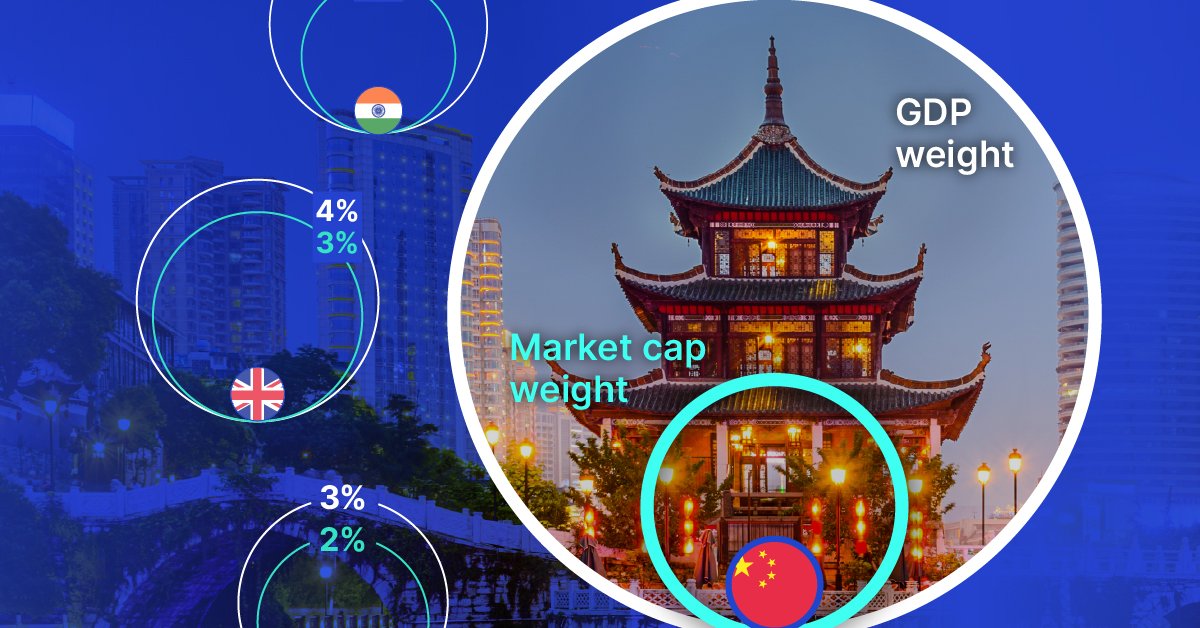China’s Economy vs. Market Cap: A Global Imbalance
Key Takeaways
- China’s GDP weight is 19% of the global economy, while its market cap is only 3% of the global total.
- In light of this, investors may consider a larger or standalone allocation in their portfolio.
As global investors consider opportunities in emerging markets, China presents a unique paradox. China’s economy is the world’s second largest, contributing nearly a fifth of global GDP. Yet its stock market accounts for only a small fraction of global equity value.
This graphic, created in partnership with MSCI, explores this gap between China’s economy and the stock market and how it compares to other countries.
China’s Economy & Market Cap in Context
China is not the only country to have a GDP weight that is larger than its market cap weight. In many other major countries, economic size outweighs stock market prominence.
However, China stands out because of the scale of its gap, whereas other countries have weightings that are much more closely aligned.
| Country | GDP Weight | Market Cap Weight |
|---|---|---|
 China China |
19% | 3% |
 India India |
4% | 2% |
 UK UK |
4% | 3% |
 France France |
3% | 2% |
 Italy Italy |
2% | 1% |
Source: MSCI. Only a selection of countries are shown.
What causes this 16 percentage point gap, and what does it mean for investors?
Factors Influencing China’s Stock Market
Due to foreign ownership restrictions and state-owned enterprises, the proportion of China’s stock market that is freely available for public trading is reduced.
MSCI’s indexes reflect this freely tradable portion, also known as the free float market capitalization. This aims to ensure the indexes are investable, diversified, and accurately represent the market. Ultimately, this means China has a low market cap weighting in a global context.
Is China Underrepresented in Portfolios?
Beyond looking at where a company is incorporated or primarily listed, investors can gauge country weights in other ways. For instance, MSCI also explored the geographic sources of company revenues.
Companies listed in the U.S., Japan, and Taiwan were partially allocated to China because they earned revenue in the country. With this analysis, China has a 10% weighting globally.
Notably, investing according to revenue exposure would be much more complex and could overlook local economic, regulatory, and political factors. However, this view does underscore how China’s 3% market cap weight in global benchmarks can underrepresent economic realities.
Investors wanting to align more closely with macroeconomic fundamentals may want to consider a standalone or larger allocation to China.

Interested in 55 years of equity market insights with clear, easy-to-digest charts? Get your free copy of MSCI’s Global Equity Investing Through the Decades report.
-

 Investor Education2 months ago
Investor Education2 months agoA New Framework for Personalized Financial Portfolio Alignment
The MSCI Similarity Score compares a client’s financial portfolio to a model portfolio based on risk exposures, allowing for personalization.
-

 Green2 months ago
Green2 months agoTracking Emissions: Corporate Concentration and Climate Progress
Just 1% of companies are responsible for the majority of public company emissions. See the progress companies are making to reduce emissions.
-

 Technology7 months ago
Technology7 months ago3 Reasons Millennials Are Driving the AI Revolution
Millennials are more likely to accept AI than older generations. What other factors could help them drive the AI revolution?
-

 Technology8 months ago
Technology8 months agoThe Fintech Frontier: How Digital Wallets Are Changing Payments
Digital wallets have become the top payment method thanks to their convenience. How can investors track innovation in fintech companies?
-

 Healthcare9 months ago
Healthcare9 months agoCharted: Deaths Related to Bacterial Infection vs. Research Efforts
Globally, nearly 14% of deaths are related to a bacterial infection—but research isn’t keeping up with the need for new treatments.
-

 Healthcare9 months ago
Healthcare9 months agoVisualizing the Rise of Antibiotic Resistance
Antibiotic resistance has nearly tripled in the last two decades, meaning treatments may no longer work for some bacterial infections.
-

 Technology1 year ago
Technology1 year agoCharting the Next Generation of Internet
In this graphic, Visual Capitalist has partnered with MSCI to explore the potential of satellite internet as the next generation of internet innovation.
-

 Investor Education1 year ago
Investor Education1 year agoHow MSCI Builds Thematic Indexes: A Step-by-Step Guide
From developing an index objective to choosing relevant stocks, this graphic breaks down how MSCI builds thematic indexes using examples.
-

 Markets2 years ago
Markets2 years agoWeathering Physical Climate Risks: A Guide for Financial Professionals
Physical hazards like fires pose climate risks for companies, due to the added costs of asset damage and business interruption.
-

 Green2 years ago
Green2 years agoVisualized: What Are the Climate Risks in a Portfolio?
This infographic shows the effects of climate change on investments, and how climate risks may affect a portfolio’s value.
-

 Green2 years ago
Green2 years agoVisualized: An Investor’s Carbon Footprint, by Sector
Which sectors are the largest contributors to emissions? From energy to tech, this graphic shows carbon emissions by sector in 2023.
-

 Investor Education2 years ago
Investor Education2 years agoWhich Climate Metrics Suit Your Investment Goals Best?
When selecting climate metrics, it is important to consider your purpose, the applicability and acceptability of the climate strategy, and the availability of historical data.
-

 Healthcare2 years ago
Healthcare2 years agoInnovation in Virology: Vaccines and Antivirals
Vaccine development has grown six-fold since 1995. Learn how virology, the study of viruses, is driving innovation in the healthcare industry.
-

 Misc2 years ago
Misc2 years agoInfographic: Investment Opportunities in Biotech
Capture the investment opportunities in biotech with the MSCI Life Sciences Indexes, which target areas like virology and oncology.
-

 Technology2 years ago
Technology2 years agoIndustrial Automation: Who Leads the Robot Race?
This graphic from MSCI shows the pace of industrial automation across leading countries like China and the U.S.
-

 Technology2 years ago
Technology2 years agoRanking Industries by Their Potential for AI Automation
AI automation is expected to impact some industries more than others. See the latest projections in this infographic.
-

 Markets2 years ago
Markets2 years agoHow Institutional Investors Can Approach Digital Assets
Digital assets are gaining popularity due to their return potential and decentralized nature. How can institutional investors get exposure?
-

 Technology2 years ago
Technology2 years agoClassifying Digital Assets With a New Framework: Datonomy
How can investors get clarity on the thousands of digital assets available? A new structure classifies digital assets by their use cases.
















